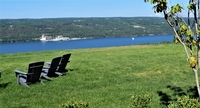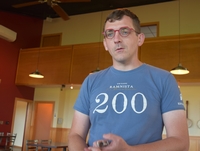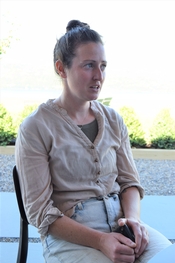Looking west from the lake’s eastern shore and across the placid waters far below, on the opposite side a few miles distant, a mid-afternoon thunderstorm, more of a local squall, really, plays peek-a-boo with the bright sun that has been encouraging the fattening grapes over here to add a bit more sugar and forget about losing acidity.
In between, the lake is deep, and not just the water – although the average plunge to the bottom is the length of a football field – but the setting of the lake itself.  Most of the activity – people, houses, roads, farming – is higher up before the land tumbles down to lakeside in a long, sometimes precipitous plunge. Most of the vineyards are spread out well above lake level, just below the hilltop and the high plain beyond, beneath its protective brow. Of the 11 digits of the Finger Lakes carved out by retreating glaciers, only Cayuga to the east rivals Seneca in size.
Most of the activity – people, houses, roads, farming – is higher up before the land tumbles down to lakeside in a long, sometimes precipitous plunge. Most of the vineyards are spread out well above lake level, just below the hilltop and the high plain beyond, beneath its protective brow. Of the 11 digits of the Finger Lakes carved out by retreating glaciers, only Cayuga to the east rivals Seneca in size.
“This area is called “the Banana Belt” because of its warmth, as opposed to further down the lake,” Kelby Russell, winemaker at Red Newt Cellars located  outside the village of Hector, told me during my recent visit. “The temperature can be 20 degrees warmer down by the lake” he says. “The red wines from the east side of Seneca tend to be darker with more berry fruitiness. But we’ve found the soil makes more of a difference in growing, especially with Riesling, than does the exposure. The soils were dropped in quilt-like, sometimes in bands.”
outside the village of Hector, told me during my recent visit. “The temperature can be 20 degrees warmer down by the lake” he says. “The red wines from the east side of Seneca tend to be darker with more berry fruitiness. But we’ve found the soil makes more of a difference in growing, especially with Riesling, than does the exposure. The soils were dropped in quilt-like, sometimes in bands.”
Taking advantage of opportunities presented by this crazy-quilt of soil patterns, as well as global warming, Russell and Red Newt Cellars are part of a small group of producers centered around Seneca Lake who are in the forefront of a renewed push for increased quality and wider critical and commercial acceptance, both in the U.S. and abroad. While a few wineries here and around the other lakes continue to emphasize the area’s traditional “roots” connection – wines made from indigenous grapes such as Labrusca, traditional French-America hybrids and more-recent Cornell University-developed hybrids – these wineries represent an ad-hoc, three-prong program of development which in the aggregate might be called Seneca Lake’s “Burgundy model.”
Central to this is that most leading wineries are identifying small vineyards or plots within larger vineyards for individual bottlings, some even referring to them as “lieux-dits” in the Burgundy fashion. While vineyards are not mutually owned as in Burgundy, these wineries frequently buy grapes from each other. Second, while not abandoning the elegant, dry Rieslings the area is known for, these winemakers are also intrigued by Burgundy’s two primary varieties – Chardonnay and Pinot Noir – along with other cool-climate grapes. A third component is that the area is cultivating and attracting outside capital and noted producers from elsewhere, resulting in a more-cosmopolitan winemaking culture. As a result, the winery owners are beginning to aggressively compete in the international marketplace, including Europe and Asia, important if the region is to gain wide recognition for quality.
Founded in 1998 by David and Debra Whiting, Red Newt today makes about 20,000 cases annually, with emphasis on single-vineyard dry Riesling, Gewürztraminer and Pinot Gris from their own and surrounding vineyards. Russell, who succeeded owner Whiting as winemaker in 2014, has also begun his own line of eponymous wines. In addition to soil types, Russell says his most-complex Rieslings come from older vines, “although I found that past around 25 years vine age has no bonus.”
In the international market, Russell says he and other local producers a few years ago signed up with different English importers and that he currently sells in England five Red Newt wines in the £29 to £49 ($35 to $60) range that are competitive with equally priced German Riesling. Red Newt also has sales in Denmark, Norway and Sweden.
A couple of miles south of Red Newt in Burdett is Forge Cellars, which, as far as origin stories goes, has one of the best. Co-owner Rick Rainey is a transplanted  Floridian who still has a casual Tommy Bahama-meets-L.L. Bean air about him – “a Rhône guy who is making Burgundy-style wines in a Riesling region.” Rainey had been intrigued by the Finger Lakes even when he was in the restaurant business and later while traveling across Europe as a wine buyer. On one of those business trips, he made friends with Louis Barruol, the talented, outspoken owner of Château de Saint Cosme in Gigondas, and convinced the Frenchman to visit the Lakes. In 2011, they became partners in Forge Cellars, and today Forge wines are sold at Saint Cosme’s cellar door, and Saint Cosme wines are on the shelves in Forge’s tasting room. “We recently shipped about 600 cases to France,” Rainey told me, “where Louis sells them at his château but also distributes them with his Rhone wines to other countries.”
Floridian who still has a casual Tommy Bahama-meets-L.L. Bean air about him – “a Rhône guy who is making Burgundy-style wines in a Riesling region.” Rainey had been intrigued by the Finger Lakes even when he was in the restaurant business and later while traveling across Europe as a wine buyer. On one of those business trips, he made friends with Louis Barruol, the talented, outspoken owner of Château de Saint Cosme in Gigondas, and convinced the Frenchman to visit the Lakes. In 2011, they became partners in Forge Cellars, and today Forge wines are sold at Saint Cosme’s cellar door, and Saint Cosme wines are on the shelves in Forge’s tasting room. “We recently shipped about 600 cases to France,” Rainey told me, “where Louis sells them at his château but also distributes them with his Rhone wines to other countries.”
Mais qui dites, “lieux-dits?” That would be Rainey, who is trying to convince his neighbors that this Burgundy identification system is a good one, although the term may not be totally apropos, as “lieu-dit” in Burgundy as well as the similar term, “climat,” signifies a small plot that has been historically recognized by that name, not always the case in the Finger Lakes. (But why argue with what could become a marketable term?) “We have identified 13 lieux-dits within an 8-mile stretch,” Rainey says. “The glacier moraine here is composed of different shales left at different levels as the glacier retreated, along with alluvial fans flaring out.” He pauses. “It’s like Burgundy, but without the distances.” The Forge’s lieux-dites bear such names as Caywood, Tango Oaks, Freese and Leidenfrost. Rainey is especially fond of the latter. “Leidenfrost is close to the water where there is lots of shale, and it makes intense, shale-tasting wines,” he says. “If I had a grand cru, it would be Leidenfrost.”
Further south from Forge, just a few miles outside of where Watkins Glen nestles into in a cove at the foot of Seneca, another famous wine person from the outside has set up shop. Earlier this year, Paul Hobbs, known for his highly ranked California and South American wines, released the 2019 Hillick & Hobbs Riesling, his first vintage. Hobbs grew up in the region – his family raised apples, although Hobbs’ father sparked his interest in pursuing a career in grapes – and he and his younger brother cleared the property for planting. In total, the new Hillick & Hobbs estate (the surname of each parent) has 78 acres, 21 of them currently planted to vines.
“The vines are planted east to west, instead of north to south, to take advantage  of the wind to keep the vines dry from mildew,” says Lynne Fahey, who serves as the estate’s first winemaker. The vineyard is planted 1,800 vines per acre, all Riesling, and the basic winemaking procedure is whole-cluster pressing with natural yeast in stainless steel and settling on gross lees. Although Hillick & Hobbs has an attractive tasting room, its wines are being made elsewhere for now.
of the wind to keep the vines dry from mildew,” says Lynne Fahey, who serves as the estate’s first winemaker. The vineyard is planted 1,800 vines per acre, all Riesling, and the basic winemaking procedure is whole-cluster pressing with natural yeast in stainless steel and settling on gross lees. Although Hillick & Hobbs has an attractive tasting room, its wines are being made elsewhere for now.
All three of these leading Seneca Lake wineries emphasize dryness, regardless of the grape, usually with a maximum four grams per liter, even for the Rieslings. However, wineries I recently visited on Seneca’s west side – some of whose vineyards supply grapes to winemakers on the east side, tended to still produce their wines a little fruitier and a little sweeter, even if some that claim complete dryness. Of course, “dry” is a relative term, but it shouldn’t be surprising that consumers who drink these “dry” Rieslings and note a lingering, sometimes cloying, fruitiness on the palate instead of a crisp finish will continue to think of all Rieslings as being sweet and not merely being uber-fruity.
There is also the fact that Riesling, while delightful to sip, is not in reality a very versatile food wine, an observation which most people in the wine trade who love Riesling would dispute. Yet why else does a large majority of wine drinkers day in and day buy something else – usually Chardonnay and Sauvignon Blanc – to drink with their evening meals, even after they have repeatedly tried Riesling? (During my visit, I got into a discussion about this with Peter Bell, the winemaking guru and Riesling fanatic who was preparing to retire at Fox Run. Bell is a very likeable fellow in addition to being a very good winemaker, but his truly horrified reaction to my words was that of a priest being told many of his parishioners think of communion as only a “fun ritual.”)
Of course, taste is never a matter of right or wrong, but it is important to recognize popular preferences if winemakers want to sell wines and still be proud of them. Which is why I believe that what is happening at Hillick & Hobbs, Forge and Red Newt, among others, is so important to the region. The Burgundy analogy is both a compelling story for consumers to fall in love with as well as being a sound business strategy – a small-plot approach with wines that are elegant and dry and with an increasing emphasis on making Chardonnay and Pinot Noir without abandoning Riesling.
Whether they are called vineyards, crus, climats or lieux dits.
Read more: Wine Columns
